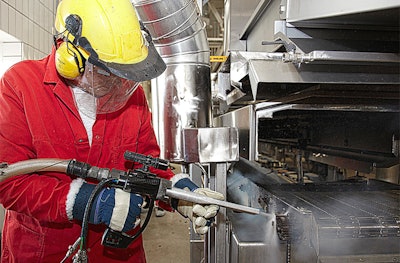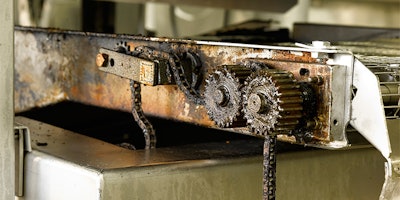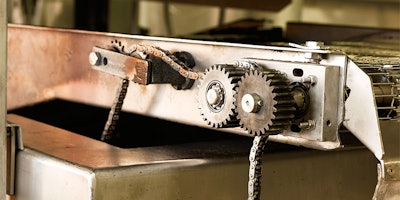

 Tyson Marlowe
Tyson MarloweDry ice cleaning is similar in concept to sand-, bead- and soda-blasting in that it cleans surfaces using a media accelerated in a pressurized air stream. But, dry ice cleaning uses solid CO2 pellets or MicroParticles, accelerated to high velocities, to impinge on the surface and clean it. The particles sublimate (turn from solid to gas) upon impact, lifting dirt and contaminants off the underlying substrate without damage.
Traditional cleaning methods are time consuming, labor intensive and costly. Manual scraping or scrubbing with wire brushes and water or chemicals can consume many hours and result in extended downtime, along with causing damage to equipment, shortening asset life and/or making it less productive. Dry ice cleaning makes cleaning easier and more complete, and enables food manufacturing or packaging facilities to quickly and easily clean a number of different surfaces and get them back into production immediately (no rinsing, drying and less disassembly).
The unique characteristics of dry ice make it the perfect media for a clean-in-place process.
- No secondary waste: Cleaning with dry ice enhances sustainability efforts. Dry ice sublimates upon impact with the surface being cleaned, which means no secondary waste, no residue and no moisture are being generated. This eliminates the added costs of extra cleanup, disposing of secondary waste streams and additional cleaning preparation, such as masking delicate sensors or wrapping electronic components prior to cleaning. The cleaning process does not use water, which allows equipment to be cleaned while online and still operating. Because it is non-conductive, dry ice cleaning allows for electrical equipment to be safely cleaned.
- Non-abrasive: Dry ice is a very soft media and can clean sensitive electronic equipment, such as printed circuit boards, without etching, profiling or changing surface dimensions.
- Non-toxic: Dry ice is a food grade media and is EPA-, FDA- and USDA-approved for use in food manufacturing. It is colorless, tasteless, odorless and non-toxic. It allows for the elimination of environmentally harmful cleaning chemicals and eliminates worker exposure to hazardous cleaning agents. It also does not produce any toxic waste that must be disposed of.
Dry ice cleaning machines are mobile and can be rolled right up to the machine being cleaned to maximize in-situation cleaning capability. Various hoses and nozzles can also be fitted to ensure that no clean is out of reach. It can also be easily integrated into manufacturing processes for different levels of automation.
Utilizing dry ice cleaning in a clean-in-place process can result in cost savings, improved productivity, the extension of equipment life and improved worker safety.
Reduce costs: Dry ice cleaning reduces labor costs because it can be done quickly by one person and in significantly less time than conventional manual labor. This enables a cleaner clean even in situations that are difficult or unpopular to clean by hand with conventional methods.
Improve productivity: It helps to reduce shut-down times, as equipment can be cleaned while hot and online. By cleaning equipment in less time, facilities are able to get more production cycles from existing equipment. Preventive maintenance or spot cleaning can also be done more frequently without impacting production.
Prolong life of equipment: Dry ice cleaning is a dry process that is non-abrasive and non-conductive — meaning it won't damage equipment and is safe for most surfaces, including electrical components.
Improve worker safety: Dry ice cleaning eliminates exposure to toxic cleaning materials. The process also eliminates repetitive motions of hand cleaning, scrubbing, chiseling or activities that require pounding, sanding or scraping.


Applications of Dry Ice Cleaning
The operational efficiencies of dry ice can be achieved in many different sectors of the food manufacturing and packaging industry. A few examples are listed below:
Bakery facilities: Dry ice is used to clean many different types of equipment and surfaces in industrial bakeries. Equipment is often coated in dough, layers of oil, bread crumbs and other baking ingredients. Manual cleaning methods are tedious and require disassembly before cleaning.
Dry ice cleaning has been proven to clean equipment such as proofers, ovens, bread coolers, baggers, chains and conveyance equipment with little to no disassembly. The equipment is cleaned in place while it is still operating. Dry ice cleaning can even be used to clean sensitive equipment, such as the blades on bread slicers.
Snack food facilities: Dry ice cleaning is used in snack food facilities to clean Ishida weighers (radial feeders and base), conveyors and areas around the conveyors, bag makers, pack-off tables and other peripheral packaging equipment. The equipment is constantly coated with oil, grease, seasoning and crumbs and needs to be cleaned regularly.
Dry ice removes contaminants quickly and efficiently, which results in higher production time and a reduction of downtime by eliminating unnecessary disassembly and startups.
Bottling facilities: When implementing dry ice cleaning, bottling facilities run more efficiently, and produce less scrap and defective product. Also, equipment lasts longer because components are not subjected to harmful cleaning solutions. Bottling facilities use dry ice cleaning to clean labelers, glue nozzles, Bag-In-Box (BIB) formers, de-nesters, palletizers and other packaging equipment.
Dry ice cleaning offers a superior process when compared with traditional cleaning solutions such as pressure washing, chemicals and hand scraping. It cleans the equipment in place and removes glue, dust, debris and other contaminants quickly and safely.
General facility cleaning: Food manufacturing facilities can get dirty. Dirt, soot, grease and oil build up can cause machinery to function improperly and can create an unsafe working environment.
Production shutdown periods are a great time to thoroughly clean the facility. Dry ice cleaning can clean a number of different surfaces quickly and efficiently. It is used to clean general equipment and facility assets, such as pipes and hoses, motors and electrical boxes, cooling fans, forklifts and many other surfaces around the facility.






















